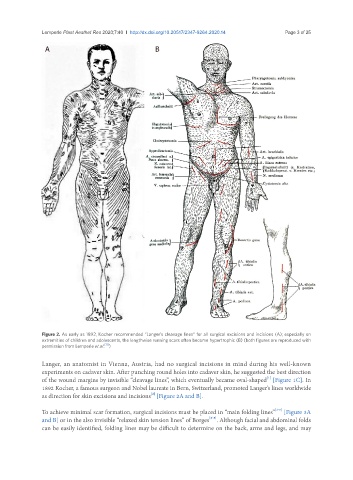Page 434 - Read Online
P. 434
Lemperle Plast Aesthet Res 2020;7:40 I http://dx.doi.org/10.20517/2347-9264.2020.14 Page 3 of 25
A B
Figure 2. As early as 1892, Kocher recommended “Langer’s cleavage lines” for all surgical excisions and incisions (A); especially on
extremities of children and adolescents, the lengthwise running scars often become hypertrophic (B) (both figures are reproduced with
[11]
permission from Lemperle et al. )
Langer, an anatomist in Vienna, Austria, had no surgical incisions in mind during his well-known
experiments on cadaver skin. After punching round holes into cadaver skin, he suggested the best direction
[1]
of the wound margins by invisible “cleavage lines”, which eventually became oval-shaped [Figure 1C]. In
1892 Kocher, a famous surgeon and Nobel laureate in Bern, Switzerland, promoted Langer’s lines worldwide
[2]
as direction for skin excisions and incisions [Figure 2A and B].
[3-5]
To achieve minimal scar formation, surgical incisions must be placed in “main folding lines” [Figure 3A
and B] or in the also invisible “relaxed skin tension lines” of Borges . Although facial and abdominal folds
[6-8]
can be easily identified, folding lines may be difficult to determine on the back, arms and legs, and may

